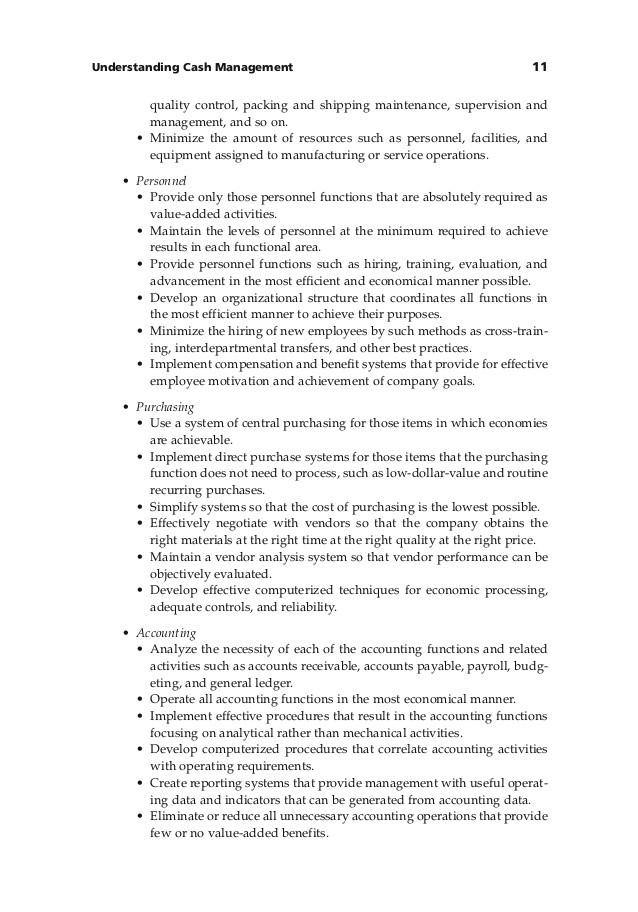What are the basics of cash flow management
Post on: 10 Август, 2015 No Comment

Confidence votes 1.2K
Cash Flow ManagementThis is advice on cash flow management from the Federal Consumer Information Center and the Small Business Administration:
Failure to properly manage cash flow is one of the leading causes of small business failures. Understanding the basics will help you with your cash flow management.
Your business’s monetary supply can exist either as cash on hand or in a business checking account available to meet expenses. A sufficient cash flow covers your business by meeting obligations (i.e. paying bills), serving as a cushion in case of emergencies, and providing investment capital.
The operating cycle is the system through which cash flows, from the purchase of inventory through the collection of accounts receivable. It measures the flow of assets into cash.
For example, your operating cycle may begin with both cash and inventory on hand. Typically, additional inventory is purchased on account to guarantee that you will not deplete your stock as sales are made. Your sales will consist of cash sales and accounts receivable credit sales, usually paid 30 days after the original purchase date. This applies to both the inventory you purchase and the products you sell. When you make payment for inventory, both cash and accounts payable are reduced. Thirty days after the sale of your inventory, receivables are usually collected, increasing your cash. Now your cash has completed its flow through the operating cycle, and the process is ready to begin again.
Cash and other balance-sheet items that convert into cash within 12 months are referred to as current assets. Typical current assets include cash, marketable securities, receivables and prepaid expenses.
Cash-flow analysis should show whether your daily operations generate enough cash to meet your obligations, and how major outflows of cash to pay your obligations relate to major inflows of cash from sales. As a result, you can tell if inflows and outflows from your operation combine to result in a positive cash flow or in a net drain. Any significant changes over time will also appear. Understanding this will lead to better control of your cash flow and will allow adequate time to plan and prepare for the growth of your business.
It is best to have enough cash on hand each month to pay the cash obligations of the following month. A monthly cash-flow projection helps to identify and eliminate deficiencies or surpluses in cash and to compare actual figures to past months. When cash-flow deficiencies are found, financial plans must be altered to provide more cash. When excess cash is revealed, it might indicate excessive borrowing or idle money that could be invested. The objective is to develop a plan that will provide a well-balanced cash flow.
Here are the basic ways that a business can increase cash reserves:
- Actively manage accounts receivable and quickly collect overdue accounts. You stand to lose revenues if your collection policies are not aggressive. The longer your customer’s balance remains unpaid, the less likely it is that you will receive full payment.
- As credit and terms become more stringent, more customers must pay cash for their purchases, thereby increasing the cash on hand and reducing the bad-debt expense. While tightening credit is helpful in the short run, it may not be advantageous in the long run. Looser credit allows more customers the opportunity to purchase your products or services. You should measure, however, any consequent increase in sales against a possible increase in bad-debt expenses.
- Loans from various financial institutions are often necessary for covering short-term cash-flow problems. Revolving credit lines and equity loans are types of credit used in this situation.
- Increased sales would appear to increase cash flow. However, if large portions of your sales are made on credit, when sales increase, your accounts receivable increase, not your cash. Meanwhile, inventory is depleted and must be replaced. Because receivables usually will not be collected until 30 days after sales, a substantial increase in sales can quickly deplete your company’s cash reserves.
Additional cash-flow techniques include the use of a bank lockbox to which all customer remittances can be sent. This allows your bank to directly deposit the funds into your account, shrinking the time it takes for the funds to show up in your bank balance.














